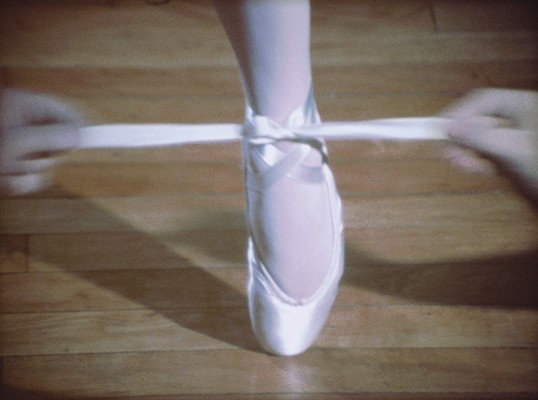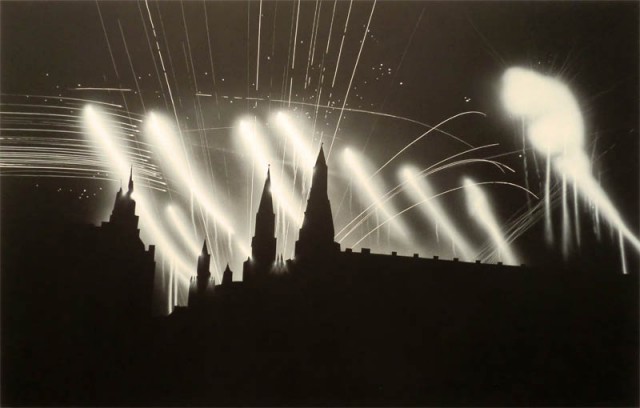
Jack Goldstein, A BALLET SHOE, 16mm film, color, silent, 1975 (Courtesy Galerie Daniel Buchholz, Berlin/Cologne and the Estate of Jack Goldstein)
The Jewish Museum
1109 Fifth Ave. at 92nd St.
Sunday, September 22, $12, 12:30 – 4:30
Exhibition continues Thursday – Tuesday through September 29, $15 (free admission Saturday 11:00 am – 5:45 pm, pay-what-you-wish Thursday 5:00 – 8:00)
212-423-3200
www.thejewishmuseum.org
www.jackgoldstein-artist.com
In 1973, multimedia artist Jack Goldstein made the short film Jack, in which he, as cameraman, backs away from a man in a desolate landscape who repeatedly calls out, “Jack,” over and over and over again as he fades into the distance. It’s a critical piece in the first American museum retrospective of Goldstein’s work, “Jack Goldstein x 10,000,” which continues through September 29 at the Jewish Museum. The self-destructive Goldstein was known for disappearing during the course of his career, both in his art and in his life, and the Jewish Museum has been examining the iconoclastic figure in a series of programs that have included the exhibition walk-through “What Is Jack Goldstein?” and the panel discussions “Where Is Jack Goldstein?” and “How Is Jack Goldstein?” The museum has saved the best for last, as the final program takes place on September 22, the afternoon symposium “Who Is Jack Goldstein?,” which features a prestigious collection of artists and historians talking about Goldstein’s influence and legacy: Morgan Fisher, Robert Longo, Matt Mullican, Troy Brauntuch, Kathryn Andrews, and Paul Pfeiffer, moderated by Julia Robinson and Claire Bishop. The exhibition itself comprises many of Goldstein’s films in addition to sculpture, sound installations, paintings, and writings. The works display Goldstein’s unique mix of wit and anxiety: In the eight-minute video A Spotlight, Goldstein runs around a room trying to avoid a spotlight, while in the “Burning Window” installation, flickering candles make it seem like a fire is raging behind a window, and there’s nothing anyone can do to stop it.

Jack Goldstein, “Untitled,” acrylic on canvas, 1981 (collection Melva Bucksbaum and Raymond J. Learsy)
Goldstein strips things down to their bare elements in such shorts as Shane, in which a German shepherd barks for three minutes, and A Ballet Shoe, in which two hands tie a ballet shoe on a ballerina’s foot. A series of instructions explains how others can stage some of Goldstein’s performances and installations, once again adding to his theme of the artist’s disappearance. In the mid-to-late-1980s, Goldstein, a heroin addict who was born in Canada in 1945 and spent time in New York before moving to California, where he studied with John Baldessari and became associated with the Pictures Generation, created colorful abstract canvases using appropriated images, the works melding science, computer technology, and psychedelia. The exhibit ends with extracts from Goldstein’s writing — influenced by his penchant for reading philosophy books backward — in which he experimented with new word-processing techniques and repurposed words from other writers in order to form his own personal narrative. In a 1985 interview with the Tate’s Chris Dercon, Goldstein, who hanged himself in his backyard in 2003 at the age of fifty-eight, said, “You wake up in the morning and look at yourself and go, ‘Who is that?’ and ‘What is that?’ and ‘What do you call it?’ and ‘What’s my name?,’” later adding, “My name, it’s the name of a name. It’s not my name. . . . Imagine, if you look in the telephone book, there must be ten thousand Jack Goldsteins.” This revealing survey goes a long way toward establishing just who this Jack Goldstein is, although all of the mysteries are likely never to be solved.